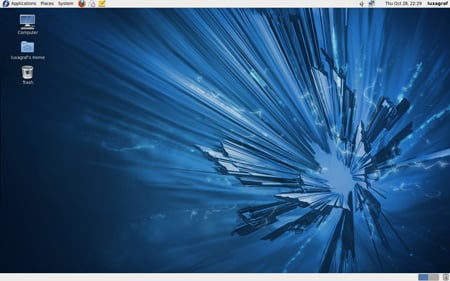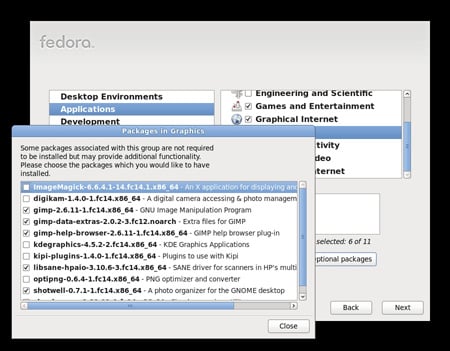Original URL: https://www.theregister.com/2010/11/03/fedora_14_review/
Fedora 14: haven for Ubuntu's homeless GNOMEs
A real performer. But will it love you back?
Posted in OSes, 3rd November 2010 18:00 GMT
Review Fedora 14, released Tuesday, has quite a bit of new stuff under the hood - things you probably won't notice most unless you're a systems admin or use Fedora for development.
For Fedora this is business as usual and, many would argue, the way it should be. After all, the latest UI bling is useless if the underlying system isn't delivering the tools you need on a rock solid foundation.
It also makes a nice contrast to Canonical's Ubuntu, which has a habit of taking Fedora's upstream contributions, wrapping them in a prettier package and stealing the limelight. There's nothing wrong with that, it's the nature of open source software - you can do what you want with it. It's just that Fedora rarely ends up getting the credit it deserves for making desktop Linux as usable as it has become over the years.
However, those who love Ubuntu's slick looks might want to take a closer look at Fedora 14. Given Ubuntu's controversial decision to switch to the Unity desktop in its next revision, it's entirely possible Fedora will look more appealing to casual users over the next year. While Fedora may be less flashy than Ubuntu, there's plenty here for exiled GNOME lovers to embrace. What's less clear is whether Fedora will return that embrace.

Fedora 14's desktop makes an eye-catching splash
Fedora has long maintained that it is not looking for users, it's looking for fellow contributors. That is, the distro doesn't want to make Linux easier for you, it wants you to help it make Linux better for everyone.
For the most part that's an academic (and marketing) distinction, but when you start comparing release notes between Ubuntu and Fedora one thing become very clear - Fedora is all about tools and foundations.
That said, there are several enhancements in Fedora 14 that any user will appreciate. For example, Fedora 14 ships with libjpeg-turbo. While that may not mean much to the average user it translates into much faster JPEG image handling and you don't have to be a system admin to appreciate faster photo apps.
The libjpeg-turbo support uses the enhanced fork of the original libjpeg project. For those running Fedora as a web server, that means faster compression and decompression for server-side apps working with image files. The updated library should also speed up any other applications working with JPEG images, including photo managers, video editors and PDF readers.
Added SPICE for Windows
Another somewhat technical, though useful, enhancement is SPICE - the Simple Protocol for Independent Computing Environments. SPICE is a framework for setting up and interacting with virtual machines. It offers accelerated graphics, encryption and video and audio tools.
For those running Windows clients in a virtual machine SPICE offers a few Windows helpers right out of the box, including a video driver, an agent for performing operations inside the guest system and virtio serial drivers for talking to the agent.
Although SPICE has been available in the repos since Fedora 12, the new tools make getting Spice up and running much easier.
Along with improvements like SPICE, desktop Linux users will find nearly the same compliment of GNOME apps that ships with Ubuntu. In some cases the app choices are different, but for the most part the two ship with roughly the same GNOME software.
Fedora jumps on Amazon's cloud
There is one thing missing in this release: Fedora no longer ships with the Pino social network client. Its absence is probably due to the fact that Pino hasn't yet updated to Twitter's new OAuth system, but the fact that Gwibber wasn't dropped in its place suggests perhaps Fedora is dropping the idea of including a Twitter client. Frankly, given Fedora's overall focus on development tools, Pino did feel a bit out of place.
Naturally just about any major GNOME app you'd like to install - including Pino 0.3 when it's finalized - is available in the Fedora repos.
Fedora 14 is moving into the cloud. The Fedora Project is releasing Fedora 14 as an Amazon EC2 image - a boon for developers. Until now the most recent Fedora release available for EC2 users has been Fedora 8 - if you wanted a more recent version of Fedora on an EC2 instance you had to install it yourself.
The new concurrent release schedule means that moving your projects from local servers into Amazon's cloud can be as easy as copying a few files to Amazon servers.
This release will also see the expansion of Fedora's netbook spin, integrating MeeGo for mobile devices. For most users that means netbooks, though MeeGo has also been adopted by Nokia for use on mobile phones.

Best Linux installer ever? Ubuntu could learn a few things from Fedora
For Fedora 14 the core MeeGo 1.0 packages are all available either as a separate spin or through Yum with yum groupinstall meego-netbook. The MeeGo integration builds on the foundations laid by the Moblin spin in previous Fedora releases.
As usual, Fedora 14 offers your choice of desktops, including GNOME 2.32, KDE 4.5, Xfce 4.6.2 and even Sugar 0.90 if you feel like trying something totally different - Sugar is probably best known as the operating system of One Laptop Per Child.
After GNOME, the KDE spin sees the biggest set of changes in this release, with version 4.5 now including the WebKit rendering engine in its libraries. That means KDE now has system-wide WebKit support that works much like the older KHTML framework, allowing any app to take advantage of WebKit for displaying content.
It's also worth mentioning that Fedora still has the best Linux installer I've used, with the option to customize and tweak your installed software before installation. It's something Ubuntu should really consider offering.
Popular scripting languages like Python, Ruby and Perl have all been updated to the latest stable releases. The updated Ruby packages mean that Fedora 14 will support Ruby on Rails out of the box.
For Python developers the ability to run Python 3.0 alongside older versions - which was introduced in Fedora 13 - remains available, making it easy for those looking to upgrade code without the need to install Python 3.0 from scratch.
Fedora 14 will also include support for D, a systems programming language that, according to the release notes, combines the power of C and C++ with the productivity-friendly approach of modern scripting languages like Ruby and Python.
Fedora versus Ubuntu?
It's been quite a year, with the polished Ubuntu 10.10 interface and new versions of Ubuntu. Is it fair to compared these two desktop rivals, though?
In some ways it's an apples to oranges comparison, so the answer is "no". On the surface Fedora looks more sedate and isn't as pretty as Ubuntu out of the box. But when it comes to desktop Linux, does anyone use the default theme?
It's under the covers where Fedora starts to look more appealing - with everything from the awesome color management tools that landed in Fedora 13, to the new virtualization and photo speed improvements found in this release.
While it may lack some of the flashier "everyday user" features Ubuntu has been focusing on, Fedora is still a very user-friendly distro, especially for those just looking to get work done without the bells and whistles of Ubuntu.
In the end both are great desktop releases, the main difference is that Fedora has more to offer once you scrape below the glossy surface. ®